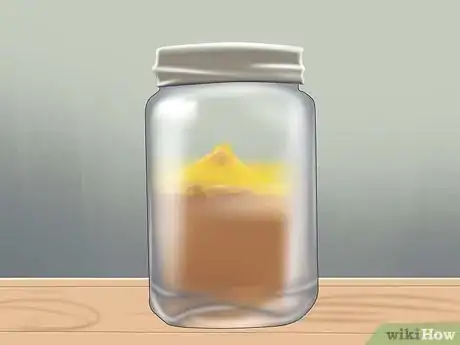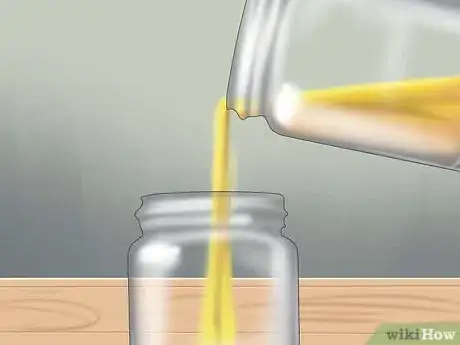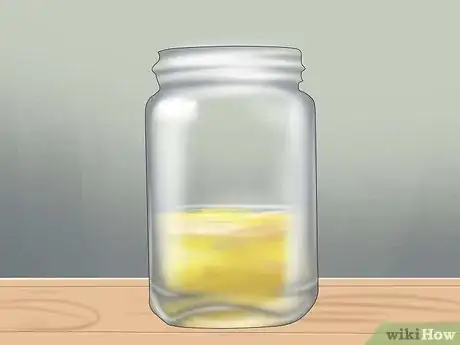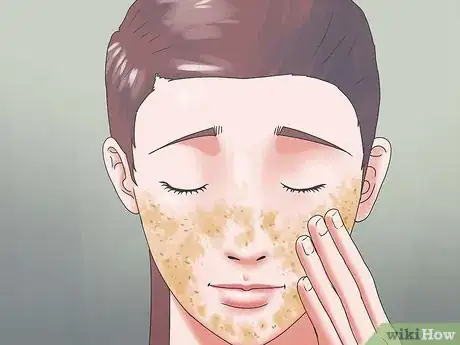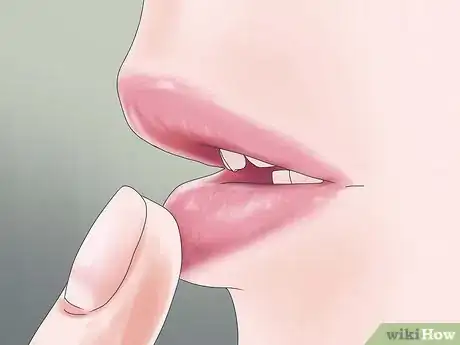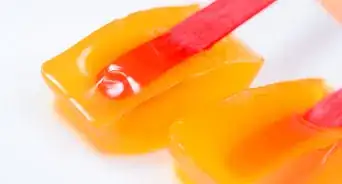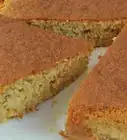This article was co-authored by Barbie Ritzman. Barbie Ritzman is a Beauty Specialist, Influencer, and the Owner of Barbie’s Beauty Bits. With over 10 years of experience in the beauty industry, she specializes in skincare and aesthetics. Barbie studied marketing at Tidewater Community College and holds a Certificate from the Media Buying Academy. For her work, she’s won Beauty Influencer of the Year - The USA and was featured in “The Allure 50,” which includes the year’s 50 most influential people in the beauty industry.
wikiHow marks an article as reader-approved once it receives enough positive feedback. This article received 13 testimonials and 100% of readers who voted found it helpful, earning it our reader-approved status.
This article has been viewed 345,352 times.
Almond oil is typically used to nourish skin and hair and is an important component of many beauty products.[1] However, it can also be used for cooking at home. If you want to know how to make your own almond oil at home, all you need is a blender and a bit of patience. You can also splurge for an oil press if you're really committed to making your own almond oil.
Ingredients
- 2 cups unroasted almonds
- 1-2 tsp. olive oil
- 2 cups roasted almonds
Steps
Making Almond Oil in a Blender
-
1Place the almonds into your blender. The almonds should be dry and fresh. Make sure your blender is clean and ready to go.[2]
-
2Blend them at low speed at first. You should start off at low speed so that the almonds are blended slowly and carefully; blending them at high speed at first will make the blending process more difficult.Advertisement
-
3Pause the blender to clean the build-up. As you start to blend the almonds, you may find that they start to form a shape that resembles a ball; they'll start to build up on the sides of the blender. Just stop the blender to scrape off the build-up and return it to the rest of the almonds. You may need to do this several times in the blending process, so be vigilant as you blend them.[3]
-
4Blend the almonds at a higher speed. As they get more and more blended, you can turn your blender up to medium or even high speed. This will help the process along.
-
5Add the olive oil when the almonds are thoroughly blended. Once the almonds have been blended into a rich, creamy paste, then you can add a teaspoon of olive oil to speed up the blending process. If you find that the almonds are still not blending as smoothly as you'd like them to, then you can add another teaspoon of oil.[4]
-
6Store the blended almonds. Once you've finished blending the almonds, you can place them in a container, such as a glass jar or Tupperware, and keep them in your fridge for about 2 weeks.[5] This should be enough time for the oil from the almonds to separate from their meat.
-
7Drain the oil. To get the most out of the oil, you can try tipping the container and letting the oil drip into a separate container.[6] You can also use a sieve or a strainer to separate the oil from the almonds.
-
8Use the oil. You can use the oil to treat your skin or hair or for aromatherapy purposes. You also don't have to throw out that leftover nut meat, either. You can use it in cooking, or even just mix it with a bit of canola oil and salt and spread it on toast.
Using an Oil Press
-
1Place the almonds in the top of the oil press. An oil press can be a bit pricier than a blender, but it can blend your almonds extra thoroughly if you're willing to splurge a bit. You should mount the press on a table or another sturdy surface.
-
2Start turning the crank. Simply turn the crank nice and slow to start to get the roasted almonds to produce oil. Unlike in a blender, you won't have to worry about the oil creating build-up on the sides of the device.
-
3Use a cup to catch the oil. Simply place a cup below the almonds and wait for the oil to be released into the cup. It'll be easier to crank the press the longer you do it.
-
4Use the oil. You can use the oil right away and won't need to wait a few weeks from the oil to separate from the nuts as you would when using a blender. However, the oil may look a bit cloudy, but that doesn't mean it will be less effective. If you'd like your oil to be more clear, just place it in a container and leave it out for a day for the particles to settle to the bottom of it.
Using Almond Oil
-
1Use the almond oil to moisturize your face. Almond oil can be used as a daily moisturizer. It can help soften skin that is dry or rough and it can also provide the skin with extra protection. You can take care of your face using almond oil without using a single chemical. To use the almond oil, all you need to do is to wet your hands with warm water and then massage about 1/2 a teaspoon of almond oil into your face.[7]
- You don't need to wash the oil off; treat it like a natural moisturizer and let it absorb into your skin.
-
2Use almond oil to make a facial mask. Another thing you can use the almond oil for is a facial mask to take care of your skin. All you need is to mix the ingredients to make the mask in a small container to create a paste that you can apply all over your face with your fingers. Apply the mask in the morning and then let it sit for 30 minutes before you wash it off with warm water. Here are the simple ingredients you'll need to make the paste:
- 1 tbsp. almond oil
- 1 tbsp. honey
- 1 tbsp. lemon juice
-
3Use almond oil as a facial scrub. A facial scrub can help clear your skin and exfoliate your face, removing dead skin cells and any dirt or grime. All you need to do is to add about 1 teaspoon of salt or sugar for every teaspoon of almond oil and stir the ingredients together until you've made a solid paste. Just gently use the pads of your fingers to rub the oil over your face and then wash it off with warm water.
- Be gentle while using the scrub. If you rub your face too much, then your skin could get a bit irritated.
-
4Use almond oil as a conditioner. If you want to use almond oil as a conditioner, all you have to do is to take about a teaspoon of it and rub it into your wet hair. Use a comb to really get it through and then cover your hair once you've fully conditioned it. Wait about 30 minutes for the oil to work its magic and then wash your hair with shampoo to get it out.
- If you do this at least once a week, you'll be on your way to healthier hair in no time.
-
5Use almond oil on dry hair. You can also use almond oil as you would use any other hair oil. Simply place about half a teaspoon of it in the palm of your hands, rub it into your hair, and comb it to thoroughly coat your hair. You can use almond oil to keep your hair looking sleek and to protect it from split ends.
- Don't apply it more than once every day or two or your hair may get too oily.
-
6Use almond oil to make lip balm. If you want to use your almond oil to care for your lips, then all you have to do is gather a few simple ingredients to make your own lip balm at home. All you need to do is to melt the ingredients in a double boiler on the lowest heat possible, remove them from the heat, and then pour them into the balm tubes and let it sit for 24 hours before you can use it. You can use the following ingredients:
- 1 tbsp. shea butter
- 1 tbsp. coconut oil
- 1 1/2 tbsp. almond oil
- 1 1/2 tbsp. beeswax
- .15 oz lip balm tubes
Expert Q&A
-
QuestionHow many almonds does it take to make almond oil?
 Lorena BarcalLorena Barcal is a Clinical Herbalist, Clean Beauty Specialist, and Writer for IslandBeauty.co, a blog dedicated to sharing the benefits of using all-natural beauty products and recipes created by herbalists. Lorena specializes in studying and developing natural alternatives for beauty products. After finishing her herbal studies, Lorena managed an herbal lab in Barcelona developing natural beauty products. As a writer for IslandBeauty.co, she shares knowledge and insights to promote the natural beauty industry.
Lorena BarcalLorena Barcal is a Clinical Herbalist, Clean Beauty Specialist, and Writer for IslandBeauty.co, a blog dedicated to sharing the benefits of using all-natural beauty products and recipes created by herbalists. Lorena specializes in studying and developing natural alternatives for beauty products. After finishing her herbal studies, Lorena managed an herbal lab in Barcelona developing natural beauty products. As a writer for IslandBeauty.co, she shares knowledge and insights to promote the natural beauty industry.
Clinical Herbalist & Clean Beauty Specialist Mix 1 cup (130 g) of almonds with 2 tbsp (29.5 mL) of olive oil to make your almond oil. Pour in a little extra oil if the mixture seems too thick.
Mix 1 cup (130 g) of almonds with 2 tbsp (29.5 mL) of olive oil to make your almond oil. Pour in a little extra oil if the mixture seems too thick. -
QuestionDoes almond oil need to be refrigerated?
 Lorena BarcalLorena Barcal is a Clinical Herbalist, Clean Beauty Specialist, and Writer for IslandBeauty.co, a blog dedicated to sharing the benefits of using all-natural beauty products and recipes created by herbalists. Lorena specializes in studying and developing natural alternatives for beauty products. After finishing her herbal studies, Lorena managed an herbal lab in Barcelona developing natural beauty products. As a writer for IslandBeauty.co, she shares knowledge and insights to promote the natural beauty industry.
Lorena BarcalLorena Barcal is a Clinical Herbalist, Clean Beauty Specialist, and Writer for IslandBeauty.co, a blog dedicated to sharing the benefits of using all-natural beauty products and recipes created by herbalists. Lorena specializes in studying and developing natural alternatives for beauty products. After finishing her herbal studies, Lorena managed an herbal lab in Barcelona developing natural beauty products. As a writer for IslandBeauty.co, she shares knowledge and insights to promote the natural beauty industry.
Clinical Herbalist & Clean Beauty Specialist Yes, you should store your almond oil in the refrigerator for 2 weeks right after making it. Then, filter the mixture into a clean glass bowl afterward.
Yes, you should store your almond oil in the refrigerator for 2 weeks right after making it. Then, filter the mixture into a clean glass bowl afterward. -
QuestionShould I use roasted almonds in the blender?
 Community AnswerNo, almonds don't need to be roasted to get the oil from a blender, although you could roast them if you wanted.
Community AnswerNo, almonds don't need to be roasted to get the oil from a blender, although you could roast them if you wanted.
Warnings
- Do not boil too much.⧼thumbs_response⧽
- Do not pour too much essential oil.⧼thumbs_response⧽
References
- ↑ Barbie Ritzman. Beauty & Skincare Specialist. Expert Interview. 23 August 2021.
- ↑ http://oilypedia.com/the-easy-way-of-how-to-make-almond-oil-at-home/
- ↑ http://oilypedia.com/the-easy-way-of-how-to-make-almond-oil-at-home/
- ↑ Lorena Barcal. Clinical Herbalist & Clean Beauty Specialist. Expert Interview. 28 June 2020.
- ↑ Lorena Barcal. Clinical Herbalist & Clean Beauty Specialist. Expert Interview. 28 June 2020.
- ↑ Lorena Barcal. Clinical Herbalist & Clean Beauty Specialist. Expert Interview. 28 June 2020.
- ↑ http://www.thedermreview.com/almond-oil-for-skin/
- ↑ Barbie Ritzman. Beauty & Skincare Specialist. Expert Interview. 23 August 2021.
About This Article
To make your own almond oil, place 2 cups of fresh, dry almonds into a blender and turn it to low speed. As the almonds start to break down, add a teaspoon of olive oil and turn the blender up to medium or high speed, stopping occasionally to clean off the sides of the cup. Store the almond paste in an airtight container at room temperature for 2 weeks, after which time you should notice that the almond oil has separated from the meat. Pour or strain the oil out of the container, then use it however you would use commercial almond oil! To make almond oil with an oil press, read on!







